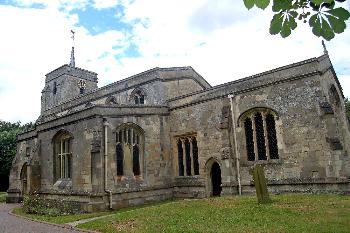Early Education in Eaton Bray

The church from the south-east August 2007
The earliest reference to a schoolmaster in Eaton Bray is in 1578. The third surviving archdeaconry court book [ABC3] states that: “John Buckmaster did mysuse the scholemaster in the Churche for beatinge of the children of the sayd John”.The Buckmaster family were owners of Doolittle Mill. The parish registers list the baptisms of following Buckmaster children in this period: Agnes 1564; Dorothy 1565; Alice 1566; Andrew 1567; Edmund and Elizabeth 1570; William 1571 and Elizabeth 1572. John’s wife Ann died in 1596 and John himself in 1601. Ironically a later Buckmaster was a schoolmaster himself - see below.
In 1654 Thomas Herbert, the schoolmaster, made his will, which was proved in 1668 [ABP/W1668/162]. There is an interesting note on this man in late 19th century minute book used by the church restoration committee [P63/2/4/4]. It reads: “Thomas Herbert who calls himself “Philo-Mathematicus” and “Student in Astrologie” compiled almanacs during the Protectorate. That for 1652, entitled Speculum Anni printed at London by Gartrude [sic] Dawson for the Company of Stationers has an Appendix dated “From Eaton Bray in Bedfordshire June the 17, 1651”.
The parish register reveals that in 1733 Ann, daughter of the schoolmaster John Cook was baptised. A will survives for John Fountain, schoolmaster, which was proved in 1765 [ABP/W1765/16] and an administration of the goods of John Buckmaster, schoolmaster, from 1750 [ABP/A1750/20].
Volume 81 published by Bedfordshire Historical Records Society (2002) is a series of episcopal visitations |undertaken in the first twenty years of the 18th century, edited by former County Archivist Patricia Bell. At each visitation a list of questions was sent out in advance, one of which enquired about the provision of schools in each parish. Responses were as follows:
- 1709: “No Public or Charity Schole”.
- 1717: “No Publick pr Private School”.
- 1720: “There is no Publick, or Charity-School, endowd or otherwise maintained in my Parish”.
In 1818 a Select Committee was established to enquire into educational provision for the poor. This was no doubt prompted, in part, by the recent foundation of two societies promoting education and specifically the building of schools. The Society for Promoting the Lancasterian System for the Education of the Poor was established in 1808 promoting schools run along the lines pioneered by Joseph Lancaster, who had himself copied those of Dr. Andrew Bell, in which older children taught their younger fellows. The Society was renamed the British and Foreign School Society in 1814,. It was supported by a number of prominent nonconformists, Lancaster himself was a Quaker, and sought to teach a non-sectarian curriculum. In answer to this perceived nonconformist takeover of local education the National Society was formed in 1811 to encourage the teaching of poor children along Anglican lines, including the catechism. The Select Committee sent a questionnaire to all parishes in the country asking for: particulars relating to endowments for the education of children; other educational institutions; observations of parish needs etc. There was no school of any kind in Eaton Bray and the curate wrote: “The poor are desirous of having the means of education”.
In the country generally the number of schools built continued to grow over the next fifteen years so that by 1833 the government agreed to supplement the work of the two societies, and local benefactors, by making £20,000 per annum available in grants to help build schools. It also prompted another questionnaire to be sent to each parish in England asking for details of local educational provision. Things had obviously moved forward in Eaton Bray as the return stated: “One Daily School, containing 5 to 10 males; supported by payments from the parents; and Two Sunday Schools, one of the Established Church, consisting of 36 children, partly supported by voluntary contributions, and partly from the parish rates; the other, in which are from 40 to 100 of both sexes, supported by collections among the Wesleyan Methodists”. In those days a Sunday School was just that, a school which met on a Sunday, usually in the church or nonconformist chapel or other similar building, teaching more than the religious topics with which they are associated today. The stage was set for Eaton Bray to have two schools, Anglican and Methodist for the next half century or so.